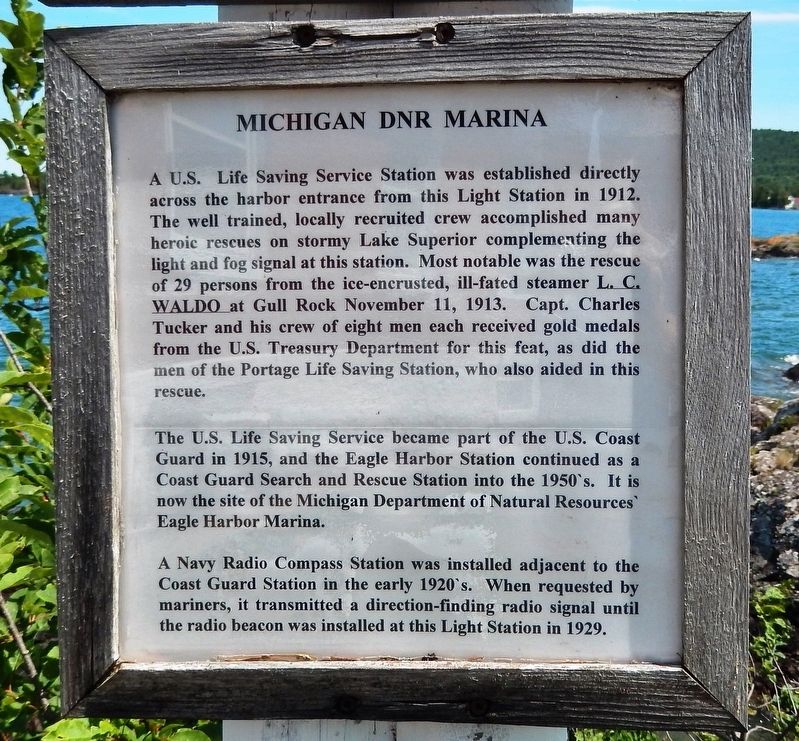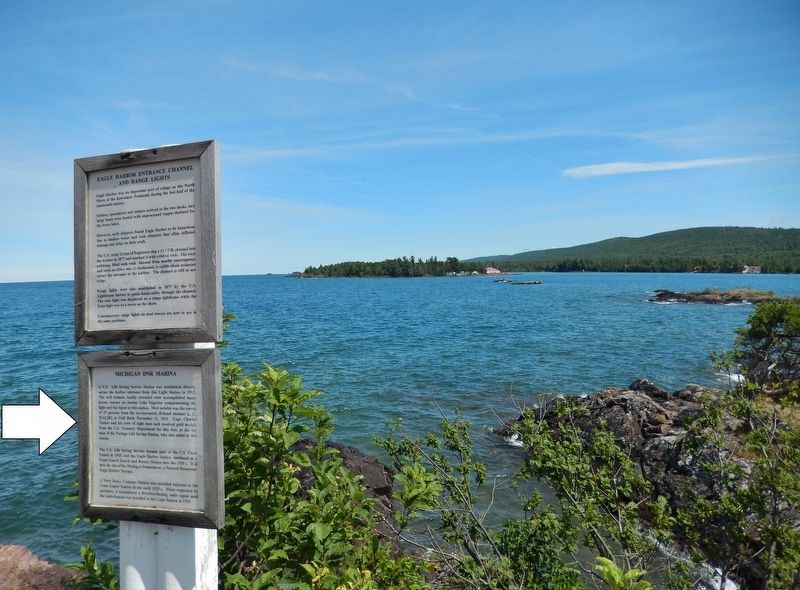Eagle Harbor in Keweenaw County, Michigan — The American Midwest (Great Lakes)
Michigan DNR Marina
The U.S. Life Saving Service became part of the U.S. Coast Guard in 1915, and the Eagle Harbor Station continued as a Coast Guard Search and Rescue Station into the 1950's. It is now the site of the Michigan Department of Natural Resources' Eagle Harbor Marina.
A Navy Radio Compass Station was installed adjacent to the Coast Guard Station in the early 1920's. When requested by mariners, it transmitted a direction-finding radio signal until the radio beacon was installed at this Light Station in 1929.
Topics. This historical marker is listed in these topic lists: Disasters • Waterways & Vessels. A significant historical date for this entry is November 11, 1913.
Location. 47° 27.574′ N, 88° 9.551′ W. Marker is in Eagle Harbor, Michigan, in Keweenaw County. Marker can be reached from Lighthouse Road north of East North Street, on the right when traveling north. Marker is located on the Eagle Harbor Lighthouse grounds, near the southeast corner of the lighthouse, overlooking Lake Superior to the north and Eagle Harbor to the east. Touch for map. Marker is at or near this postal address: 670 Lighthouse Road, Mohawk MI 49950, United States of America. Touch for directions.
Other nearby markers. At least 8 other markers are within walking distance of this marker. Eagle Harbor Entrance Channel and Range Lights (here, next to this marker); Wood-Stock Anchor (within shouting distance of this marker); Riveted Bell Buoy (within shouting distance of this marker); Fog Signal Building (within shouting distance of this marker); Eagle Harbor Lighthouse and Museums (within shouting distance of this marker); Iron-Stock Anchor (within shouting distance of this marker); Eagle Harbor (about 700 feet away, measured in a direct line); The Eagle Harbor General Store (approx. 0.2 miles away). Touch for a list and map of all markers in Eagle Harbor.
Also see . . .
1. Eagle Harbor Coast Guard Station (Wikipedia). The Life-Saving Station at Eagle Harbor was constructed in the period 1910-1912 by the United States Life-Saving Service. The original station complex included the station building with a hip-roof watch tower at the corner and a two-bay boathouse.
In 1938 the original boathouse was replaced with the current structure. In 1954, the station was turned over to the General Services Administration as surplus. (Submitted on July 18, 2020, by Cosmos Mariner of Cape Canaveral, Florida.)
2. The 1913 Life-Saving Rescue of the L.C. Waldo. The Waldo faced winds and seas so harsh that the pilot house and was torn away and the steering damaged. The vessel ran aground on Gull Rock, a little patch of rock and reef two miles off the coast of Michigan. The Waldo then broke in two, and the crew took shelter in the forward part of the steamer, where the freezing waves and spray soon formed a wall of ice that sealed them inside... (Submitted on July 18, 2020.)
3. Why the 'White Hurricane' of November 1913 was the Great Lakes' worst disaster in history. The Great Storm of 1913 was easily the Great Lakes region's largest natural disaster ever. It was four days of chaos that packed blizzard conditions as well as hurricane-force winds. If you were on a ship out on the lakes, caught in this unexpected storm, it became something out of nightmare. Mariners reported winds gusting to 100 mph in some spots, amid monster 36-foot waves. (Submitted on July 18, 2020, by Cosmos Mariner of Cape Canaveral, Florida.)
Credits. This page was last revised on July 18, 2020. It was originally submitted on July 18, 2020, by Cosmos Mariner of Cape Canaveral, Florida. This page has been viewed 118 times since then and 10 times this year. Photos: 1, 2. submitted on July 18, 2020, by Cosmos Mariner of Cape Canaveral, Florida.

